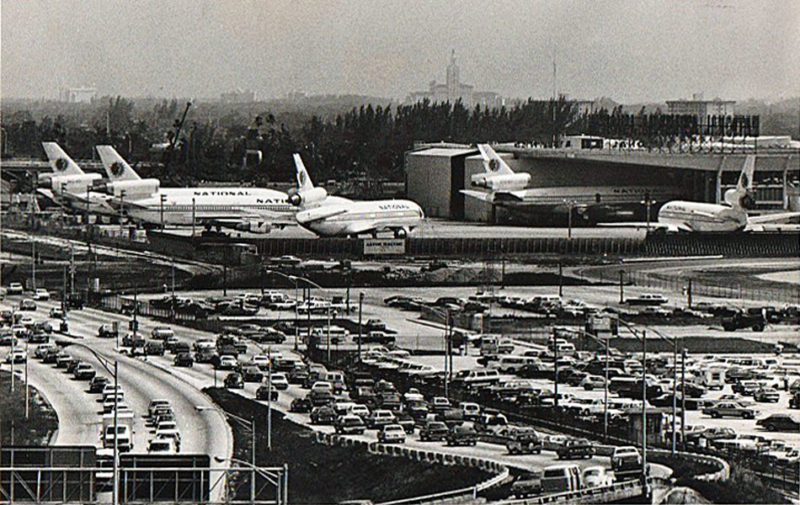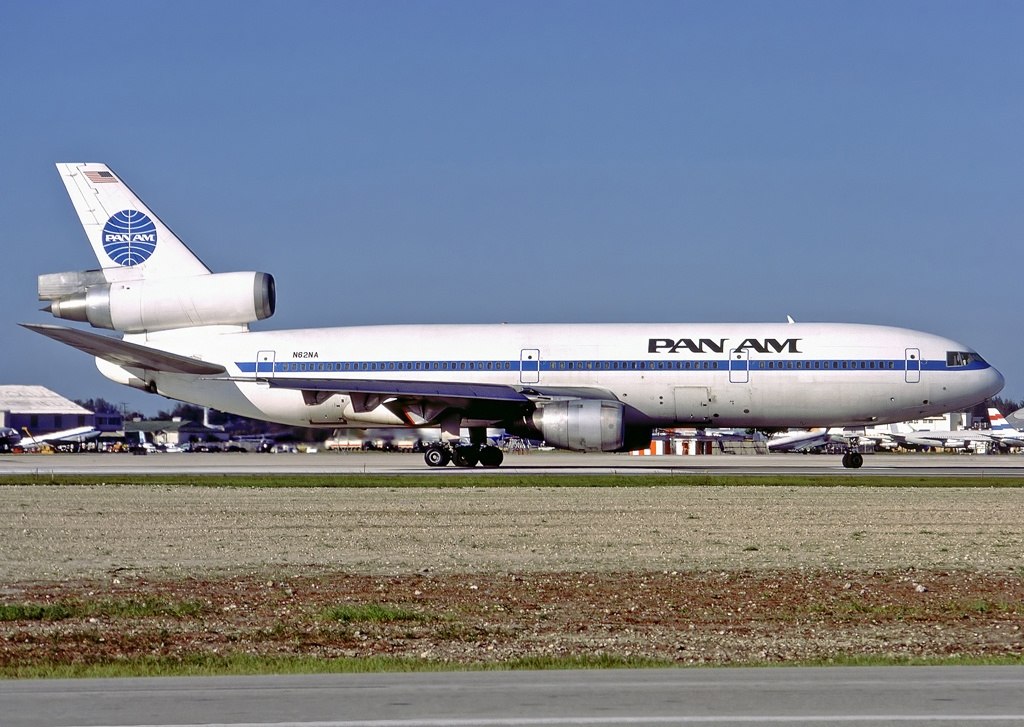The story of Pan Am’s McDonnell Douglas DC-10s starts with National Airlines, a domestic US carrier based in Miami, Florida. In 1968 it ordered 11 of the short/medium-haul -10 variant, with the first example (N60NA) entering service on December 15, 1971. National then ordered six long haul DC-10-30s in 1972 starting with N80NA joining the airline on June 11, 1973.
Pan Am by this point was one of the most famous airlines in the world flying with an extensive network of purely international services. The Airline Deregulation Act of 1978 meant that US airlines could now fly wherever they wanted; thereafter the only government regulation was operational oversight to ensure safety. While this opened up international routes to domestic carriers it also meant domestic flying in the US was possible for Pan Am. This not only opened up a huge new source of revenue but could also feed its international services.
However, creating a domestic route network would be a massive project. It would mean opening dozens of new stations, but also acquiring lots of aircraft. Apart from a few Boeing 727s and 737s for short-haul flights in West Germany and Europe (as part of the post-war settlement in Europe, only US, French and British airlines were allowed into West Berlin), Pan Am had just long-haul aircraft. Pan Am’s then CEO William T Sewell and his team felt such a build-up would take years and instead looked around for an existing US domestic operation to buy, and soon had National Airlines in their sights.
Purchase of National Airlines
Pan Am’s biggest international hub was New York’s John F Kennedy International Airport, whereas National had more of a southern accent. The bigger obstacle to acquisition was that National was an enticing proposition for ambitious upstart Texas International Airlines, which quickly acquired 24.6% of National’s shares.
Pan Am emerged the winner after a bidding war, paying $437m to buy National Airlines and officially taking control of the airline on January 7, 1980. Although National possessed a valuable infrastructure and a fleet of 43 Boeing 727s (19 of the -135 variant and 24 stretched -235s) and 16 DC-10s (11 of the -10 variant and five long-range -30s), Sewell had overpaid.

The deal, initially trumpeted as ‘the coup of the decade’ soon became better known as ‘Sewell’s folly’. With the added cost of repainting the fleet with Pan Am’s blue meatball, rebranding the stations and merging two workforces, the total cost to Pan Am was at least half a billion dollars — more like two billion dollars in today’s money.
Order for L1011 Tristars
Pan Am was mainly focused on the Boeing 747 for its widebody fleet, however four months before the takeover of National it had ordered twelve Lockheed L1011-500 TriStars. These were for long-haul routes that didn’t have enough passengers to justify a 747. The first example, N504PA, arrived on April 11, 1980 and went into service from New York JFK to Caracas. Many routes, especially on the Atlantic, saw TriStar and DC-10-30 service interchangeably.
With an already weak balance sheet, the National acquisition was an enormous burden and assets were soon being shed to shore up Pan Am’s finances. First to go was the 50% share of business jet manufacturer Falcon Jet Corporation in the summer of 1980, followed by the sale of the iconic New York headquarters building for $400m in November.
Pan Am’s controlling share in InterContinental Hotels was sold in early 1981 but before the deal was completed, Sewell’s time at the carrier came to an end, and he was replaced by Ed Acker, previously of Air Florida and Braniff.
The 727s, newly painted in Pan Am’s white and blue livery, operated mostly on the same routes they flew in National’s white, orange and yellow. The final DC-10-30 of National’s order, N84NA, was delivered to Pan Am, on August 6, 1980 bringing its fleet of the type to seventeen. The DC-10-10s flew the former National Airlines trunk routes from Miami to New York JFK and Miami to California, with some trips stopping in Houston or New Orleans.
DC-10 Operation
The DC-10-30’s long range made them ideal for thinner transatlantic trips out of Pan Am’s JFK Worldport and they were soon appearing at European airports such as Paris/Orly, London/Heathrow, Frankfurt, Amsterdam, and Munich. One of the -30s, N84NA, was leased for one year to LAN Chile, from June 12, 1981, until June 13, 1982, reregistered CC-CJN, painted in LAN livery and operated mostly long-haul flights from the Chilean capital Santiago to other major South American cities and up to Los Angeles and Miami.
Pan Am’s incoming CEO Ed Acker had a reputation for tinkering with schedules and configurations at his previous two airlines, which had made them profitable, and it was his suggestion that some of the DC-10s be reconfigured in an ultra-high density layout of ten abreast in a 3-4-3 configuration, and used as people-movers to destinations in Europe without premium class demand such as London/Gatwick, Prestwick and Stockholm, as well as Caribbean sunspots such as St Lucia, San Juan and Barbados. However, even this bold move didn’t bear fruit and Acker was soon looking to offload the DC-10s, and found a slightly unconventional method of disposing of them.
In time for 1983’s peak summer season, Pan Am had swapped some aircraft with Flying Tigers, which had three Boeing 747-212B passenger aircraft used on charters and trooping flights. Pan Am took the Flying Tigers passenger liners in return for four 747-121F pure freighters which were underused by Pan Am and were a much better fit for Flying Tigers’ global freight-hauling business.
This gave Acker an idea about a suitable new home for his DC-10s. American Airlines had taken delivery of sixteen passenger 747-123s at the start of the 1970s but experienced the same difficulty filling them as the other US domestic carriers and grounded eight in 1974, converted them to freighters and sold them to Trans Mediterranean Airlines of Lebanon and to Flying Tigers. The remaining eight soldiered on flying almost exclusively from New York/JFK to Los Angeles and San Juan (Puerto Rico), the only routes busy enough to fill a jumbo.
When American moved its main hub from New York to Dallas in the early 1980s, its 747s flew from Dallas to London/Gatwick and to Honolulu. Ultimately, no matter which of American’s routes they were deployed on, American’s 747s were simply too big whereas the DC-10, of which they already had thirty-five (all series -10s) were a better fit.
Swapping DC-10 for B747
For Pan Am, having started the age of global mass transit with its 747s and become an airline geared around that type, standardising on the 747 made more sense, so a swap was agreed. American’s eight 747-123s went to Pan Am and all but one of the seventeen Pan Am DC-10s went to American.
The DC-10s were ferried to Tracor Aviation at Santa Barbara north of Los Angeles, one or two at a time. They were given heavy checks and reconfigured for American Airlines while being stripped of their livery in favour of their new owner’s bare silver.
First to go was N68NA, which left Pan Am on November 1, 1983, and the last was N70NA, ferrying to Santa Barbara on June 20, 1984. This left the final example, N84NA, which went to United Airlines on April 29, 1985 as part of a $750 million sale of Pan Am’s entire Asia Pacific operation (about $1.7bn in today’s money). In the same year, Pan Am started to dispose of its TriStar 500s, with three sold to Delta Air Lines and three to the Royal Air Force. The remaining six were later sold to United Airlines.
Not too many years later Pan Am foundered, ceasing operations on December 4, 1991.
The former Pan Am DC-10s outlived the airline, flying on into the 1990s with American Airlines. Towards the turn of the century, American started to receive new Boeing 777-223ERs and its ageing fleet of trijets found new homes with operators including Hawaiian Airlines, FedEx Express, Omni Air International.
The last Pan Am DC-10 was in service at FedEx Express, registered N554FE (previously N66PA), the sixty-second DC-10 built. It was retired in December 2016 and parked in Victorville, California. The rest of the fleet has been scrapped or is derelict but, like the airlines they flew for, are still remembered.
Cover Image: Wikimedia Commons/Perry Hoppe




